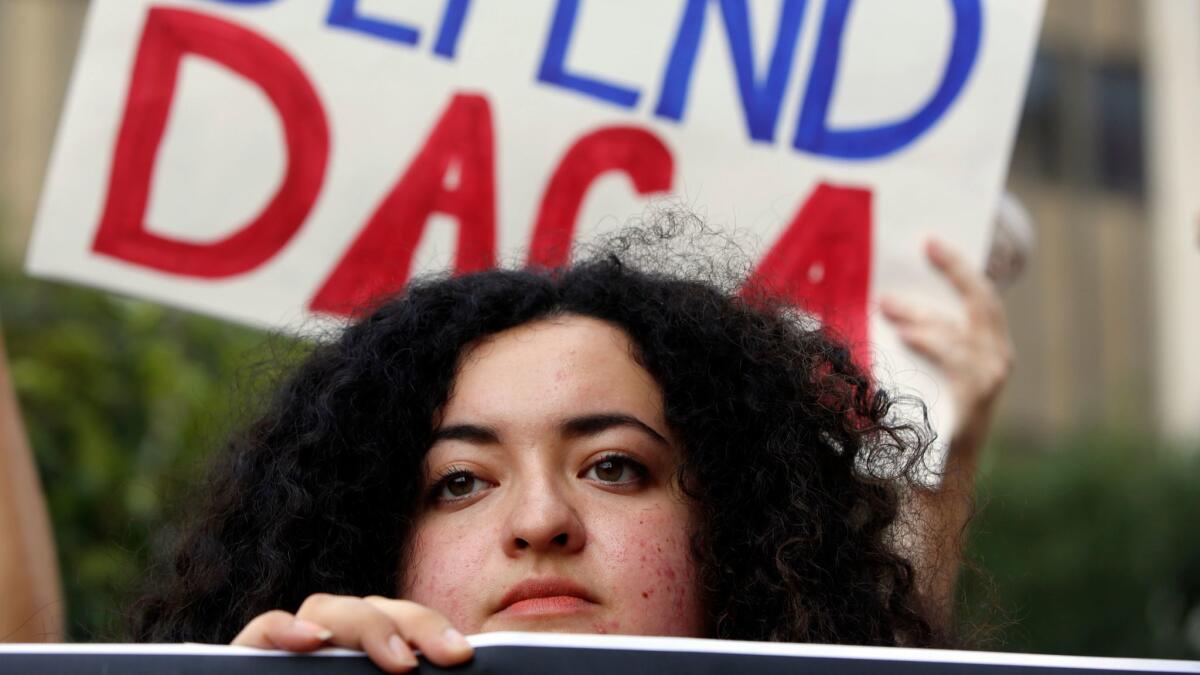Op-Ed: ‘Dreamers’ are pawns in the immigration wars

- Share via
There was always a risk that the roughly 700,000 DACA beneficiaries would become pawns in our larger immigration policy wars. For all his past expressions of support for the “Dreamers,” President Trump appears to see protecting them mainly as a lever for extracting hard-line, anti-immigration measures from Congress, which House Republicans obligingly bundled into a list of demands for the Democrats.
Above all, Trump seeks substantial funding for his project to build some sort of wall along the U.S.-Mexico border. Republican immigration hawks in Congress have their sights set on a much larger goal: reducing the overall level of legal immigration by replacing our family reunification-based legal immigration system with a “merit-based” system that privileges people with educational, linguistic and job-related credentials.
But the bipartisan compromise bill now being cobbled together in Congress focuses on that famous wall. Support is building to fund a “smart wall” — not the 2,000-mile, continuous physical barrier often promised by Trump, but rather a combination of technological upgrades for surveillance, more Border Patrol agents and new or replacement barriers along some segments of the border.
Whatever the specs, these new border enforcement measures would not come cheaply, and they would accomplish little to nothing in terms of actually preventing or discouraging illegal entries, as a large body of academic research on the efficacy of our post-1993 border enforcement buildup has demonstrated.
This sterile debate on border security moves us no closer to a serious effort to enact comprehensive immigration reform.
Trump’s wall certainly won’t cost $18 billion, as the administration has claimed. The most credible estimates by government and independent researchers are in the range of $22 billion to $40 billion. Maintenance would cost an additional $500 million per year.
Even if built to the administration’s specs, the proposed wall would slow down people-smugglers and their clients by only a few minutes or even seconds. Top Border Patrol officials argue that even a short delay would enable Border Patrol agents to swoop in and apprehend would-be illegal entrants. But there is no evidence to support this claim, and much evidence suggesting that people-smugglers would quickly adapt to the new environment and find ways to keep doing business as usual.
Worse, building a more formidable obstacle course on the southwestern border would give people-smugglers a pretext for charging their clients higher fees. It would also give unauthorized migrants who make it into the country a stronger incentive to remain permanently.
Funding the measures that are now on the table, moreover, would divert resources away from things that could actually improve border security — like more staff for inspections at legal ports of entry, where between one-third and one-half of all unauthorized entries take place, according to field research interviews.
The border wall — “smart” or otherwise — would have virtually no effect on drug trafficking, which has become the Trump administration’s primary rationale for the project. Every year the U.S. Drug Enforcement Agency publishes statistics showing that at least 95% of drugs seized were being transported through legal ports of entry. The image of drug-filled backpacks being toted across the border by undocumented migrants — an image much beloved by immigration hawks in Congress — is fantasy.
Border apprehensions are now down to 1970s levels, despite a recent surge caused mostly by migration of Central American asylum-seekers — not Mexicans. Non-Mexicans outnumbered Mexicans among apprehended migrants in the last two fiscal years.
None of the proposals under consideration would create a refugee admissions system that responds realistically to the demand for such visas. The Trump administration has reduced the annual quota of visas for asylum-seekers to 45,000 — the lowest in decades. No one has proposed new funding for programs to reduce gang violence and other push factors in refugee-sending countries.
The battle over those protected under the Deferred Action for Childhood Arrivals program remains heavily cloaked in the struggle to enact tougher “border security” measures. Democrats are under intense pressure to cave on this portion of the anti-immigration agenda. Better to play along with Trump and congressional immigration hawks on border enforcement than risk the futures of 700,000 deserving young people, the logic goes.
But this sterile debate on border security moves us no closer to a serious effort to enact comprehensive immigration reform, which must happen. We need such reform to create a pathway to legal status for the estimated 11 million undocumented immigrants now living in the United States. Trump says he supports comprehensive reform, but his statements and actions say otherwise.
Wayne A. Cornelius is a professor emeritus of political science at UC San Diego and director emeritus of the university’s Mexican Migration Field Research Program.
Follow the Opinion section on Twitter @latimesopinion or Facebook
More to Read
A cure for the common opinion
Get thought-provoking perspectives with our weekly newsletter.
You may occasionally receive promotional content from the Los Angeles Times.






